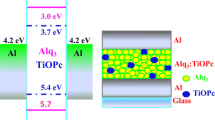Abstract
The influence of iodine on the electrical properties of sandwich structures of magnesium phthalocyanine (Mg Pc) thin films with gold and aluminium electrodes has been investigated. The various electrical properties and different electrical parameters of the iodine-doped Mg Pc thin film devices have been estimated and compared with the values of normal Mg Pc devices from the analysis of the current-voltage characteristics. Generally samples showed an asymmetric conductivity both under forward and reverse bias. From our study we found that iodine doped Mg Pc films showed an enhanced electrical conductivity of nearly ten times that of typical Mg Pc. At low voltages the films showed an ohmic conduction with a hole concentration of P0 = 6.34 × 1018 m−3 and hole mobility μ = 9.16 × 10−5 m 2 V−1 s−1, whereas at higher voltage levels the conduction is dominated by space charged limited conduction (SCLC) with a discrete trapping level of 1.33 × 1022 m−3 at 0.63 eV above the valance band edge. The ratio of the free charges to trapped charges (trapping factor) for the doped samples was found to be 1.07 × 10−7. Furthermore the reverse conduction mechanisms have also been investigated. From the current limitations in the reverse condition a strong rectifying behaviour was evident which was attributed to Poole-Frankel emission with a field-lowering coefficient of value 2.24 × 10−5 eV m1/2 V−1/2.
Similar content being viewed by others
References
N.B. Mckeown: Phthalocyanines materials, synthesis, structure and functions, Cambridge university press, Cambridge, 1998.
K.M. Kadish, K.M. Smith and R. Guilard: The Porphyrin Handbook, Academic Press, San Diego, 2003.
K.P. Krishna Kumar and C.S. Menon: “Electrical and optical characterization of vacuum evaporated magnesium phthalocyanine thin films”, J. Sol. St. Chem., Vol. 128, (1997), pp. 27–29
S. Ambily and C.S. Menon: “The effect of growth parameters on the electrical, optical and structural properties of copper phthalocyanine thin films”, Thin Solid Thin Films, Vol. 347, (1999), pp. 284–288.
G.B. Kamath, C.M. Joseph and C.S. Menon: “Effect of air annealing on the electrical and optical properties of MgPc thin films”, Mat. Lett., Vol. 57, (2002), pp. 730.
K. R. Rajesh and C.S. Menon: “Estimation of the refractive index and dielectric constants of magnesium phthalocyanine thin films from its optical studies”, Mat. Lett., Vol. 53, (2002), pp. 329.
M.C. Petty: “Gas sensing using thin organic films”, Bio Sensors And Bio Electronics, Vol. 10, (1995), pp. 129.
K. Kudo, D.X. Wang, M. Iizuka, S. Kuniyoshi and K. Tanaka: “Organic static induction transistor for display devices”, Synthetic Metals, Vol. 111, (2000), pp. 11–14.
V.R. Zakamov, V.A. Panteleev, L.G. Pakhomov and G.L. Pakhomov: “Ion beam doping of chlorinated copper phthalocyanine thin films”, High Energy Chem., Vol. 36, (2002), pp. 80–84.
C. Granito, J.N. Wilde, M.C. Petty, S. Houghton and P.J. Iredale: “Toluene vapour sensing using copper and nickel phthalocyanine Langmuir-Blodgett films”, Thin Solid Films, Vol. 285, (1996), pp. 98–101.
G.C. Bryant, M.J. Cook, T.G. Ryan and A.J. Thorne: “Liquid crystalline polymeric phthalocyanines”, J. Chem. Soc.-Chem. Commun., Vol. 4, (1995), pp. 467–468.
P. Gregory: “Industrial applications of phthalocyanines”, J. Porphyrins and Phthalocyanines, Vol. 4, (2000), pp. 432–437.
S. Ambily and C.S. Menon: “Electrical Conductivity Studies and Optical Absorption Studies in Copper Phthalocyanine thin Films”, Solid State Commun., Vol. 94, (1995), pp. 485–487.
C.M. Joseph and C.S. Menon: “Device preparation and characteristics of Cu Pc transistor”, Mat. Lett., Vol. 52, (2002), pp. 220–222.
K.P. Khrishnakumar and C.S. Menon:“Determination of the thermal activation energy and grain size of iron phthalocyanine thin films”, Mat. Lett., Vol. 48, (2001), pp. 64–73.
K.N.N. Unni and C.S. Menon:“Electrical and optical studies on nickel phthalocyanine thin films”, J. Mat. Sci. Lett., Vol. 19, (2000), pp. 2003–2005.
M. Pfeiffer, A. Beyer, T. Fritz and K. Leo: “Controlled doping of phthalocyanine layers by co sublimation with acceptor molecules. A systematic seebeck and conductivity study”, Appli. Phys. Lett., Vol. 73, (1998), pp. 3202.
Q. Zhou and R.D. Gould: “The effects of oxygen doping and annealing on the surface and bulk electrical conductivity in planar copper phthalocyanine thin films for gas-sensing applications”, Thin Solid Films, Vol. 317 (1998), pp. 432–435.
M.E. Azim Araghi and A. Krier: “The influence of ammonia, chlorine and nitrogen dioxide on chloro-aluminium phthalocyanine thin films”, Appl. Surf. Sci., Vol. 119, (1997), pp. 260.
T.D. Anthopoulos and T.S. Shafai “Electrical properties of alpha-nickel phthalocyanine/aluminium interfaces: effects of oxygen doping and thermal annealing”, J. Phys. Chem. Sol., Vol. 64, (2003), pp. 1217–1223.
Maissel & Glang: Hand Book Of Thin Film Technology, Mc Graw Hill, New York, (1993), pp. 11.
K.R. Rajesh and C.S. Menon: “Investigation of electrical properties of organic schottky diodes using MgPc-the effect of oxygen absorption and post deposition annealing”, Semiconductor Sci. Technol., Vol. 20, (2005), pp. 464.
T.S. Shafai and T.D. Anthopoulos: “Junction properties of nickel phthalocyanine thin film devices utilising indium injecting electrodes”, Thin Solid Films, Vol. 398, (2001).
Author information
Authors and Affiliations
About this article
Cite this article
Varghese, A.C., Menon, C.S. Influence of iodine on the electrical properties of magnesium phthalocyanines thin film devices. centr.eur.j.phys. 4, 20–29 (2006). https://doi.org/10.1007/s11534-005-0003-9
Received:
Accepted:
Issue Date:
DOI: https://doi.org/10.1007/s11534-005-0003-9




